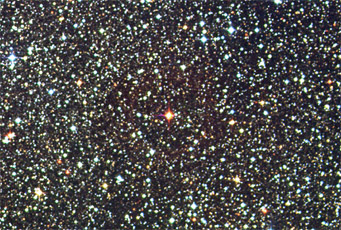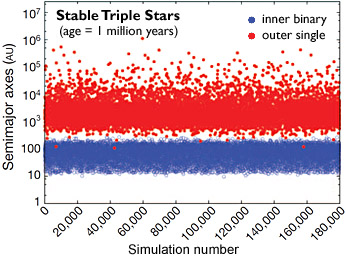Astronomers have wondered for nearly a century why some binary stars seem to orbit each other at impossibly large distances. New simulations might reveal the underlying cause: they're often triples in disguise.
Last month, while chasing the Moon's shadow in the South Pacific, I had a few nights to lead some stargazing sessions. Among the southern splendors on display was Alpha Centauri, which, I told my group, was the closest star in the night sky. Technically, it was a little white lie. The Alpha Centauri that gleams so brightly in the southern sky, actually a tight double star, lies 4.37 light-years from us. But this duo has faint, 11th-magnitude companion, Proxima Centauri, that's actually a bit closer, 4.21 light-years.

The closest star to our Sun is Proxima Centauri, the small red star in the center of this image. Discovered in 1915 and just 4.22 light-years away from us, Proxima is roughly 15,000 astronomical units (1.4 trillion miles) from its siblings in the Alpha Centauri triple star system. Click here for a larger view.
David Malin / Anglo-Australian Obs.
Proxima has been a puzzle ever since its discovery in 1915. It's very far from Alpha Centauri A and B, about 15,000 times farther than the Earth-Sun distance or roughly 0.25 light-year. Astronomers don't think it formed so far away — no single clump of condensing interstellar gas would likely have been so large. Perhaps Proxima was captured as a cluster of newly formed stars started to disperse — just as the Pleiades are doing today.
But Proxima is hardly a rare exception. In recent years observers have found that about 10% of such ultrawide binaries are in fact triple-star systems, typically anchored by a tightly bound pair of relative massive stars and a lower-mass outlier (often an M dwarf, like Proxima) quite far away.
Bo Reipurth (University of Hawaii) and Seppo Mikkola (University of Turku, Finland) think they know what's going on. They ran computer simulations that followed the evolution of 180,000 hypothetical triple stars. These triplets form close together in dense, localized "cores" within larger interstellar clouds in which a great many stars are coming together. Within 100 million years, 90% of these trios become gravitationally unstable (usually through close encounters with their neighbors) and get flung apart. But about 10% stay together — matching their abundance in the real universe.

This plot of 180,000 computer simulations shows the orbital spacing of stable triple-star systems 1 million years after they formed. Many of these systems' outlying members (shown in red) have not yet reached their apoapses, the most distant points in their orbits.
R. Reipurth / S. Mikkola / Nature
The key to survival seems to be establishing a hierarchical pecking order: the triplets interact in a way that brings two members closer together while pushing the third ever farther away. The pair whirling in close proximity can appear to be a single star telescopically unless examined carefully. As Reipurth and Mikkola conclude in the December 5th issue of Nature, their simulations imply that the widest binaries should actually have three stars, not just two.
However, some ultrawide binaries really are just twosomes. In these cases, Reipurth suggests, initially close pairs have merged into a single star. That can happen if there's enough gas remaining in the cloud core to create orbital drag and cause them to spiral into each other. Or perhaps there's some other cause that awaits discovery.
Observers can test Reipurth and Mikkola's outcome by seeing if the distant outcasts in each ultrawide system do in fact have the lowest masses, or by confirming that all three stars in a hierarchical triple have the same age. Another test would be to determine whether all this chaotic rearrangement can still allow planets to form. Just two months ago, a team of European observers announced that there's an Earth-mass planet orbiting Alpha Centauri B.
I'm headed to Costa Rica in March to get another southern-sky stargazing fix, and I hope to get my hands on a scope large enough (at least 8 inches) to resolve Proxima Centauri. But, successful in that quest or not, I've got newfound respect for this well-known stellar survivor.
 4
4
Comments
Peter Wilson
December 29, 2012 at 7:20 am
"Or perhaps there's some other cause that awaits discovery." There’s no perhaps about it. These 3-star systems are not static. Anytime the number of objects in a gravitational systems exceeds two, "duality" is possible: part of the system may be contracting, powering expansion of another part. If the outer star in these trios is orbiting the inner pair in the same direction as they are orbiting each other, tidal interactions will cause the outer star to spiral away, while the inner pair will spiral inwards. Gravitational energy released as the close pairs spiral inwards is coupled to the expansion of the outer star‘s orbit. Such a system is dualistic: it expands and contracts at the same time, depending on which part you are looking at. Now increase the number of stars simulated from 3 to 100, giving them random starting positions and velocities. The stars that start out close will tend to clump even closer together, and those farther away will get flung even further. Duality. Now increase the number of stars in the simulation to a thousand, a million, a billion. Duality is part of the picture in every case. Counterintuitively, gravity causes expansion as well as contraction in complex systems. Understand that, and you begin to understand the expansion of the universe.
You must be logged in to post a comment.
EMH
December 29, 2012 at 4:07 pm
These combo's are fascinating. My early reading often had the comment that there were many, possible more, double star systems than single star systems. Now one reads of multiple star systems since most are just that: double, triple, or more.
The dynamics are intriguing. As the previous post says they certainly aren't static.
Good luck on your trip, may you find the perfect scope and clearest skies.
You must be logged in to post a comment.
Bruce
December 29, 2012 at 5:37 pm
Yes, Peter Wilson, when I read this article I could see that it had duality written all over it. I for one thank you for helping me see that gravity can also drive expansion as well as contraction. If two stars drawing closer can drive a third farther away then two galactic clusters can drive a third galactic cluster out as well. Why couldn’t this be at least part of the reason for universal expansion or it’s observed acceleration?
You must be logged in to post a comment.
Peter Wilson
December 30, 2012 at 6:36 pm
Bruce: Appreciate your response, because the editors at Sky&Tel probably think I am hallucinating. What comes to mind is the phrase "paradigm shift." Duality is like the gorilla in the famous attention test (http://www.youtube.com/watch?v=vJG698U2Mvo). Once you see it, it’s obvious, but it remains completely overlooked by officialdom. Now that you understand duality you see it wherever it crops up. Yet the only answer to your question I have ever received from the PhDs is, "You’re wrong," a silly response to the suggestion that something has been overlooked. Duality may or may not account for the universe’s expansion and acceleration, but we will never know until it is included in the model. Cosmologists need to go back to square-1, put the dualistic factors (R, LD and eta) into Einstein’s field equations, and then re-solve them.
You must be logged in to post a comment.
You must be logged in to post a comment.